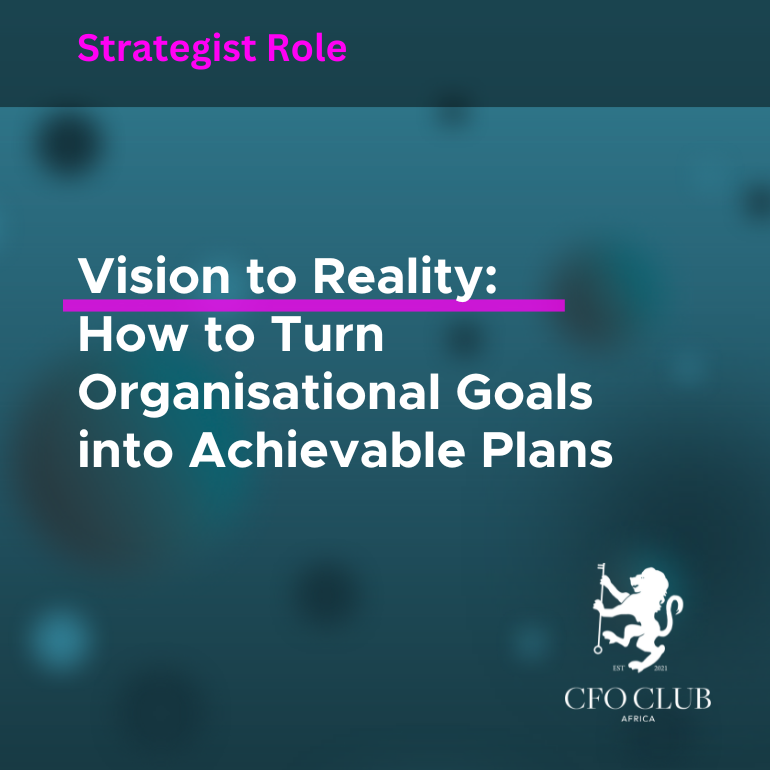Vision to Reality: How to Turn Organisational Goals into Achievable Plans
Every organisation has a vision—a statement of purpose and a picture of the future it strives to create. However, for a vision to make a meaningful impact, it must be transformed into actionable steps that lead to measurable outcomes. As a CFO, you play a critical role in bridging this gap. Your unique perspective on finance and strategy places you at the center of turning big-picture ideas into achievable plans that drive the business forward.
Here’s how to navigate this journey effectively.
Understanding the Vision
Before crafting any plan, you must deeply understand the organisation’s vision and its implications. A vision is more than a slogan; it represents the long-term aspirations of the business. Ask critical questions:
- What does success look like?
- Who are the primary stakeholders affected by this vision?
- What are the measurable outcomes we aim to achieve?
For example, a vision to become a leader in sustainability might translate into specific objectives like reducing carbon emissions, investing in renewable energy, or achieving industry certifications. Breaking down the vision into such tangible components provides clarity.
Prioritising Objectives
Not all goals can be pursued simultaneously. Determining which objectives to tackle first is crucial for efficient resource allocation and maximum impact. Begin by assessing the potential return on investment for each initiative.
- Use a SWOT Analysis to evaluate internal strengths and weaknesses alongside external opportunities and threats.
- Apply the Pareto Principle by identifying the 20% of efforts that will drive 80% of the results.
For instance, if revenue growth is a key focus, prioritise initiatives that directly influence customer acquisition or product pricing strategies.
Translating Goals into Actionable Plans
Broad goals like “improve efficiency” or “increase market share” can feel overwhelming without actionable steps. Break them into smaller tasks using the SMART framework:
- Specific: Clearly define what needs to be done.
- Measurable: Identify metrics to track progress.
- Achievable: Ensure the plan is realistic within current constraints.
- Relevant: Align it with broader organisational goals.
- Time-bound: Set a deadline for completion.
For example, instead of aiming to “reduce costs,” create a plan to “decrease operational expenses by 15% over the next six months through process automation and renegotiating supplier contracts.”
Aligning Budgets with Strategy
As CFO, your expertise in financial planning is essential to align budgets with strategic priorities. This involves:
- Allocating funds to high-impact projects while trimming non-essential expenses.
- Using tools like zero-based budgeting to ensure each expense is justified.
- Creating contingency budgets for unexpected challenges.
Financial discipline is key to ensuring that resources are used efficiently and support the organisation’s overall goals.
Engaging Teams for Execution
Turning plans into reality requires buy-in from all levels of the organisation. Assemble cross-functional teams to ensure alignment and collaboration. Clearly define roles and responsibilities, so everyone understands their contribution to the larger vision.
- Schedule regular updates to track progress.
- Foster open communication to address challenges promptly.
- Encourage accountability by linking individual performance to strategic objectives.
By involving the right people and maintaining transparency, you can ensure smooth execution and sustained momentum.
Tracking Progress with KPIs
Key Performance Indicators (KPIs) are critical for monitoring progress and making data-driven adjustments. As a CFO, establish relevant metrics to evaluate success:
- Financial KPIs: Revenue growth, profit margins, and cost reductions.
- Operational KPIs: Production efficiency, employee productivity, or customer retention rates.
- Strategic KPIs: Market share, innovation milestones, or sustainability achievements.
Regularly review these metrics with stakeholders and adjust plans as needed to stay on track.
Remaining Flexible and Adaptable
The business landscape is unpredictable. Economic shifts, regulatory changes, or market disruptions can challenge even the most well-crafted plans. Build flexibility into your strategy:
- Develop contingency plans to mitigate risks.
- Foster a culture of agility where teams can pivot quickly in response to external factors.
- Periodically revisit assumptions to ensure they remain valid.
Adaptability is not a sign of weakness but a critical strength that ensures long-term resilience.
Celebrating Wins and Learning from Setbacks
Reaching milestones is a significant achievement. Celebrate successes to boost morale and reinforce the value of the team’s efforts. At the same time, analyse setbacks to uncover lessons that can inform future strategies. This balance of recognition and reflection keeps the organisation moving forward.
Conclusion
Turning organisational goals into achievable plans is a process that requires clarity, discipline, and adaptability. As a CFO in South Africa, you are uniquely equipped to guide this transformation. By prioritising objectives, aligning budgets, engaging teams, and tracking progress, you can ensure the organisation’s vision becomes a tangible reality. Success is not just in setting ambitious goals but in executing them with precision and purpose.

